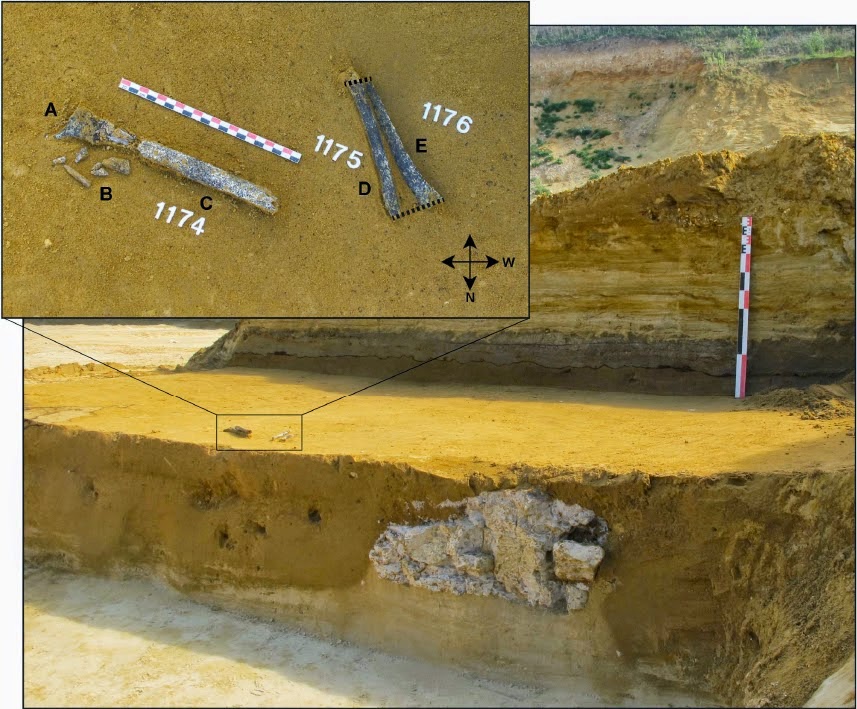Stone tools associated with the Acheulian technology first appeared
around 1.75 million years ago and spread across much of Eurasia from about 900
000 years ago onwards. The technology is typified by tools in which pieces are
chipped away from a central core to leave a useable item such as a handaxe. The
Levallois technology appeared in Africa around 300 000 years ago and spread
across Eurasia by about 200 000 years ago. In Levallois technology the chips
derived from a central core are themselves used as cutting tools, which the
core is retained as a source of material rather than being used as a tool in
itself, enabling a larger number of tools to be fashioned from a single piece
of usable rock. This is thought to be a major conceptual shift, and is
associated with the appearance of Early Modern Humans in Africa and
Neanderthals in Europe. In technical terms the Archeulian technology is
considered to be Early Palaeolithic while the Levallois is Middle Palaeolithic.
In a paper published in the journal Science on 26 September 2014, a
team of scientists led by Daniel Adler of the Department of Anthropology at the
University of Connecticut describe a site in Armenia at where obsidian
tools belonging to both the Acheulian and Levallois technologies have been
found.
The Nor Geghi site was discovered in 2008 in Hrazdan Gorge on the
edge of the Armenian Volcanic Highlands. At the site obsidian (glassy volcanic
rock) tools were found to be being eroded from a 135 m section on the west side
the side of the gorge. The rocks here comprise sedimentary rocks interbedded
with basalt lava flows derived from the Hatis, Gutanasar, and Mensakar
volcanoes in the Gegham Range. These basalts are amenable to isotope dating
methods, with the layer above the stone tools dated to 197 000 years ago, while
the layer below is dated to 441 000 years ago, while an unconformity located
below the stone tools produced sand grains dated to 308 000 years ago,
suggesting the tools were deposited between 197 000 and 308 000 years ago (an
unconformity represents a period when sediments were being eroded rather than
deposited, sedimentary sequences associated with rivers typically contain many
unconformities, as the river shifts is course and erodes where it had once
deposited).
The Acheulian and Levallois tools at Nor Geghi appear to be eroded
from a single plane, implying that they were made at the same time, and
presumably by the same people (the alternative theory, that two different
groups were living in the area and both visiting the site to make tools is
rejected, since all human groups likely to have been in the area at the time
are thought to have been intelligent enough to adopt a better technology if
they saw it being used). This implies
that the tool-makers were in the process of switching from one technology to
the other when occupying the site. This is significant, as it is currently
widely believed that the Levallois technology was developed in Africa and then
spread to Eurasia, replacing the earlier Acheulian technology. At Nor Geghi a
transitional stage is for the first time recorded outside of Africa, suggesting
that the development of a the new technology was not confined to a single
place, but developed independently from the old technology across the Old
World.
Obsidian artifacts from Nor Geghi.Levallois: (1 and 2)
recurrent cores; (3, 11, 13 to 15 and 17) flakes; (4) point with retouched
base; (5 to 8) blades; (9 and 10) preferential cores. Non-Levallois: (12)
scraper with Quina retouch; (16)biface. Adler et al. (2014).
See also…
Early and Middle Pleistocene Human remains are extremely rare in
northern Europe, having to date been found only at a single location (Biache-Saint-Vaast)
in France, as well as three locations in the UK (Swanscombe, Boxgrove and
Pontnewydd) and seven...
The Nefud Desert lies in the northwest of Saudi Arabia, and is
thought to have been one of the key obstacles that early Humans, and other
Hominids, had to pass as they expanded out of Africa into Southwest Asia. The...
The Thar Desert covers over 200,000 km² of land in the northwest part
of the Indian Subcontinent, straddling the border between Pakistan and
India. It marks the boundary between the deserts of North Africa and the...
Follow Sciency Thoughts on Facebook.




